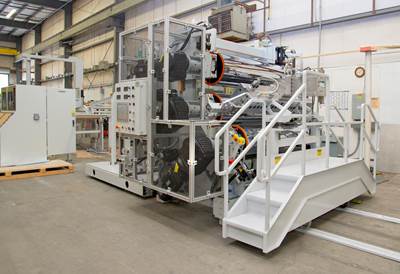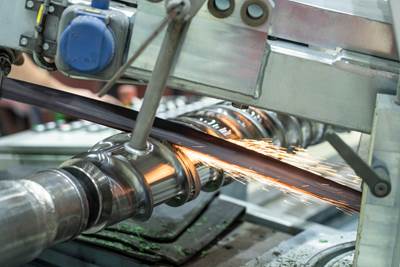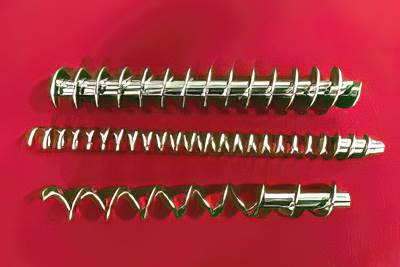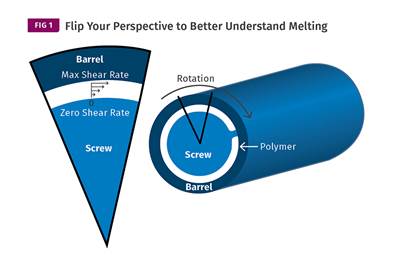Plastics Extrusion
Extrusion is a continuous process through which parts of a fixed cross-sectional profile are made. Material is fed through a hopper into an extruder, essentially a rotating screw surrounded by a heated barrel, where it is mixed, melted and pumped through a die. The die gives the part its shape. Types include film extrusion, sheet extrusion, pipe, profile and tubing extrusion.

Narrow Your Extrusion Search
ESSENTIAL READING
VIEW ALLShredding Thin Film: How to Do It Right
While many processors recoil at this task, a little know-how in shredding equipment, processing, and maintenance should add the necessary confidence.
Read MoreWhat You Need to Know About Melt-Temperature Measurement in Single-Screw Extruders
Measuring the discharge temperature is not so simple, especially when using thermocouples positioned in the transfer line just upstream of the die.
Read MoreHow to Select the Right Cooling Stack for Sheet
First, remember there is no universal cooling-roll stack. And be sure to take into account the specific heat of the polymer you are processing.
Read MoreWhy Are There No 'Universal' Screws for All Polymers?
There’s a simple answer: Because all plastics are not the same.
Read MoreWhat to Know About Your Materials When Choosing a Feeder
Feeder performance is crucial to operating extrusion and compounding lines. And consistent, reliable feeding depends in large part on selecting a feeder compatible with the materials and additives you intend to process. Follow these tips to analyze your feeder requirements.
Read MoreUnderstanding Melting in Single-Screw Extruders
You can better visualize the melting process by “flipping” the observation point so the barrel appears to be turning clockwise around a stationary screw.
Read MoreLatest Extrusion News And Updates
Nordson, Fimic Announce 'Enhanced' Partnership
Details of partnership to be divulged at K 2025.
Read MoreMaag to Buy Sikora
Complementary products to deepen companies’ “joint value proposition and integration with OEM partners and end customers.”
Read MoreNo-Dry Twin Screw Extruder Series Can Handle Multiple Resins
Machine can process a variety of virgin, postconsumer, postindustrial resins and flake without first having to crystallize, dry or change screws.
Read MoreExtrusion Veteran Scuralli Starts Sales Rep Firm
Former owner of Wayne Machine & Die to represent suppliers of extrusion systems and components.
Read MoreExtruder Drives, Motors Ease Switch from DC to AC
Advances bring extruder drives and motors closer to Industry 4.0 technology.
Read MoreNovel Extruder Takes Unique Approach to Feeding, Melting
MixFlow extruder relies on conductive heating to melt plastics, upending conventional wisdom on how plastics melt inside conventional screw extruders.
Read MoreFeatured Posts
Shredding Thin Film: How to Do It Right
While many processors recoil at this task, a little know-how in shredding equipment, processing, and maintenance should add the necessary confidence.
Read MoreHow Compression Ratio Impacts Extruder Performance
Let’s investigate how compression ratio affects performance of an extruder processing LLDPE.
Read MoreA Processor's Guide to Making World-Class Multilumen Tubing
Process innovation is pushing catheter design to the limit. Here are Lubrizol’s tricks of the trade.
Read MoreNew System Utilizes EMF Technology to Measure Sheet Thickness, Temperature
An altogether different approach to in-line measurement is said to provide direct thickness measurement, is impervious to material density changes, installs quickly and does so without radiation.
Read MoreUse a Process Assessment to Determine the Benefits of Screw-Design Modification
This type of analysis analysis will provide the converter with a clear picture of whether changes to the screw could provide economic gains through increased rate, yield, and quality.
Read MoreAutomated Die, Feedblock System Improves Efficiencies at Cast Film Processor
Reifenhäuser's PAM automation systems helps Bogucki Folie reduce waste at startup while slashing time between changeovers.
Read MoreFAQ: Extrusion
However, there are actual limits on increasing output as L/D is increased. Usually these limits are due to the inability of the feed section to deliver more polymer. On smaller-diameter screws, that limit often is determined by screw strength. On small screws you can only go so deep in screw channels before the screw is over torqued and fails. On larger extruders, the efficiency of feeding decreases as the channels get deeper until there is no further increase in output.
There are four main things to consider in selecting the correct stack for your application: the overall cooling capacity, the products to be processed, the mechanical capability, and the rolls’ internal design. Considering just the cooling capacity, the top roll is there to set the sheet thickness as well as its uniformity.
One of the most useful evaluations is the relatively simple calculation of drag flow. Drag flow is simply half the volume of one turn of the metering section per second at a specific screw rpm, which, when multiplied by a units conversion and the melt specific gravity of the polymer, is a very accurate approximation of the output in lb/hr at no head pressure.
Extrusion Supplier Categories
- Web Winders, Unwinds, Rewinds
- Single-Screw Extruders
- Saws
- Orientation & Tentering Equipment (for Webs)
- Pipe Corrugators
- Slot Orifice Coaters
- Extruder Screens, Screen Packs, Screen Changers, Breaker Plates, Other Melt-Filtration Equipment
- Sheet Take-off Systems
- Film Take-off Systems
- Web Brakes, Clutches, Chucks
- Extrusion Dies
- Pipe Bellers
- Web Inspection Systems
- Pipe Take-off Systems
- Web Guides, Edge Detectors
- Wire & Cable Take-off Systems
- Pipe Thickness Measuring Equipment
- Roll Coaters
- Dispensing Equipment for Reactive Resin Systems
- Melt Pumps for Extrusion
- Curtain Coaters
- Profiles, Tubing, Hose Take-off Systems
- Calenders
- Cutoff Equipment
- Plastic Lumber Extrusion/Molding Systems
- Web Slitter/Rewinders
- Knife Coaters
- Film, Sheet, Coated Web Thickness Measuring Equipment
- Web Tension Controls
- Multiple-Screw Extruders
- Web Cleaning Equipment
- Coextrusion Dies, Feedblocks
- Web Slitters
- Plasma Coating Systems
- Ram Extruders
- Air Knife Equipment
- Monofilament/Multifilament Take-Off Systems
- Rotary Screwless Extruders
- Pelletizers
- Solution Casting Equipment (for Film)
- Air Rings & Internal Bubble Cooling Units
- Profiles, Tubing, Wire Thickness Measuring Equipment

















